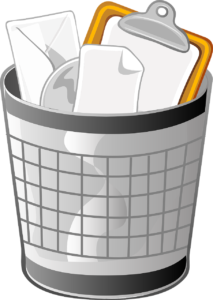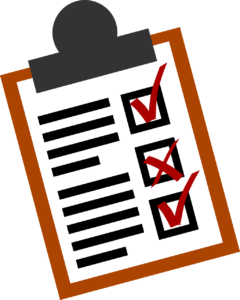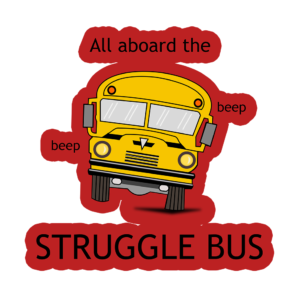Trying to Do More with Less? How About Doing LESS with Less?
How many times have we heard others grumble about needing to do more with less? How many times have we struggled to do more with less ourselves?
I’m here to tell you that when you have less, perhaps the first step is not to figure out how to do the same amount and range of activities with less, but to reassess whether the full range and amount of activities you were doing are still required, or even advisable. In other words, should you be doing LESS with less?
This is not to say that being efficient isn’t important, but increasing efficiency alone is not enough, and not even the best solution to working with resource constraints. Whole business school courses have been taught on this subject, namely, the LEAN method of refining business processes.
Some of you may be shaking your heads and thinking, “LEAN isn’t for me. I’m not a business. I’m just running buses.” That’s where you’re wrong! Do you have budget management responsibilities? Do you have to manage resources? Do you have to deliver services? If so, you are a “business” in all the ways that matter.
LEAN is a lens of looking at what you and your organization are doing and finding the ways in which waste has nosed its way in when nobody was looking. What is waste? “Waste” is – an unnecessary activity that adds little to no value or makes things worse. It can include an activity or process that does not add value for you. In normal LEAN talk, there are 8 commonly recognized categories of waste. If you care about learning a little more about what exactly these categories are and how they might show up in a transportation operation, read on.
8 Commonly Recognized Categories of Waste
Waste
How This Waste Might Manifest in a Transportation Department
Overproduction
Stops with no students assigned, seats assigned to students who don’t ride, students without bus assignments.
Waiting
Waiting for updated student files for school start. Is there a seamless daily download of information as well as an upload into your SIS? Do you have planned reports to give to the Drivers, Schools, and Administration?
Transport
Inefficient routing of school buses, causing long student rides and increasing operational costs Are we able to plan for the students that will ride the bus? How do we identify eligible students that do not ride?
Motion
Inefficient arrangements of office spaces or distances between bus garages and the office that require people to waste time shuttling between places.
Over Processing
Not having efficient ways to perform tasks like planning routes because phantom stops and students are included, or because tasks are re-executed due to inefficient process sequencing.
Inventory
Unused seats (over and above the ones planned for students who don’t ride); underutilized vehicles (e.g., single-tiered schedules).
Defects
Mistakes.
Misused/Unused Human Potential
Office staff (dispatchers, routers, etc.) who are also required to drive buses, personnel whose time is not efficiently used because of the lack of training or tools, or because they are performing work that could better be contributed or performed by another part of the organization.
 Generally speaking, nobody sets out with a plan to design a system or process that has waste in it. Usually, unless you are a saboteur, you intend to do things that need doing and not to do things that don’t need doing. Simple enough, right? So how do so many of us end up with bloated systems with too much irrelevant stuff in them and inefficient processes?
Generally speaking, nobody sets out with a plan to design a system or process that has waste in it. Usually, unless you are a saboteur, you intend to do things that need doing and not to do things that don’t need doing. Simple enough, right? So how do so many of us end up with bloated systems with too much irrelevant stuff in them and inefficient processes?
Let’s pay a little visit to Poros’ (happens to share a name with the Greek god of expediency, wouldn’t you know) transportation department. Poros completed a relatively successful first year of software-aided routing and is now ready to get set up for the next year. He’s got some students who are graduating or leaving the district, so he gets them out of the system. So far, so good! Then he rolls over the kids who are staying and pushes to the next grade level. Still pretty good! Then he adds the new kids. He’s three for three! He notices that he’s got some stops in his routing plan that he won’t need anymore but thinks to himself, he’s got some driver education he wants to do, so he moves on to other things. He can do this maintenance-type stuff later! Later, when he gets to routing the kids for Year 2, it’s no big deal to ignore the stops he’s not using anymore. There are only a few!
Fifteen years go by.
Poros has even less time now than he did in Year 1. He’s been promoted a few times, but mostly that means he has more responsibility and the same amount of time (sound familiar?). His routing system is now completely littered with stops that have no students assigned to them, and it’s a huge pain to visually skip over them, or to look through them to find whether a stop he now wants already exists (so sometimes he just creates a new stop anyway because it takes too long to look) and…do we see where this is heading? Poros made what seemed like a time-saving choice in the short run, but that time-saving choice led to waste in his system.
 As a result of duplicate stops at corners, students can be assigned stops with different numbers. Additionally, stops being assigned to runs are different numbers than the stops assigned to students. The stop locations are correct, but the students do not have bus assignments. This mirrors the stop assigned to the run as the stop is correct it shows zero students at the stop. The end result is a lot more phone calls to the transportation department with confused parents.
As a result of duplicate stops at corners, students can be assigned stops with different numbers. Additionally, stops being assigned to runs are different numbers than the stops assigned to students. The stop locations are correct, but the students do not have bus assignments. This mirrors the stop assigned to the run as the stop is correct it shows zero students at the stop. The end result is a lot more phone calls to the transportation department with confused parents.
Now, let’s pay a visit to Cassandra’s district. Cassandra has been telling her superintendent for years that the driver shortage is really becoming an issue, but she’s been able to make little adjustments here and there to make it work. Mostly, most of the kids are getting to school on time. It’s not pretty but it’s also not intolerable. Then School Start 2021 comes. We’re over a year into COVID. A lot of drivers have simply exited the workforce. Cassandra tried to make a few more adjustments here and there, but on the first day of school, 20% of her already-reduced driver team simply didn’t show and she has no way of really knowing if they’ll show up the next day. Under these circumstances, Cassandra cannot “do more with less” and she has run out of room to tweak. Now it's time to do less with less (well, actually, April or May 2021 was probably the time to plan to do less with less, but better late than never!). Maybe the district has to take a hard look at revising their walk boundaries, reducing the number of riders. Or maybe the district has to consider not accommodating activities and field trips with yellow buses, opening up time for Cassandra to implement a multi-tiered system. No matter what, the time for small tweaks and easy decisions is over. Going to group stops to make runs quicker and double trip the buses may need to be evaluated. Earlier drop-off times may be needed. Bell time adjustments may be required to plan for double trip runs. Walk distance to stop may have to be reviewed.
Why Is LEAN Thinking a Useful Tool?
LEAN is a really useful lens through which to look at what you’re doing, in part because it is so intuitive. Think about most sports, whether it’s basketball, running, swimming, diving, or my own favorite, weightlifting! Athletes who are at the top of their game in their sport have fine-tuned their movements so that there is as little “extra” as possible. The most successful weightlifters are the ones who can move the barbell in the absolute straightest path from floor to overhead (and if you’ve got a good strength/height ratio, all the better!). Runners and swimmers train for hours to get extreme efficiencies of movement. The Tokyo 2020 Olympics was a festival of LEAN!
Here's the catch – you knew this was coming! After all, if LEAN is so intuitive, why do so many of us struggle along with systems and processes full of waste? Why can’t we just get off this particular struggle bus?
The concept of LEAN itself is intuitive. But applying it is NOT, because applying it requires that you be able to take a look at your operation in an unbiased way. And unpacking and dismantling habits is very hard. This is why it took a horrified dinner guest to help me realize that my years’-long practice of keeping baggies of baby teeth on the refrigerator was not a particularly good way to save my boys’ baby teeth. It got even worse when, under her smirking pressure, I couldn’t even really tell her whose teeth were in which baggie. And finally, I had to confront the question of why I bothered keeping all those baby teeth anyway? I put off answering that question for later. (I do still have them somewhere. I am sure this is a deep violation of LEAN.)
So how do we get from here to LEAN? Perhaps with a LOT of discipline and unshrinking honesty, we look at we could have been doing differently and better all along. Or you could invite a true baby-teeth-baggie-seeking friend over for dinner.
Here at Edulog, we have a whole team of people who have been that baby-teeth-baggie-seeking friend and who would be happy to help you identify and deal with the baggies of baby teeth in your operation. If you’re wondering if you even have any baggies, or you think you might have seen some baby teeth somewhere, and you want some help, reach out to us to see how we can help! Or maybe you’re a serious athlete and you want us to fine-tune your movement? We have lots of pro-level coaches here who can do just that! Or are you a student transportation professional who is interested in learning more about how LEAN thinking can help you do less with less? We have people for that, too!
Schedule a Free Consultation With One of Our Experienced Team Members
With the ever-changing landscape of student transportation, school districts are often forced to be creative or do more with less. Let Edulog help you find safe, efficient, and effective solutions to meet the unique needs of your operation. Whether you are building a new environment with a hybrid schedule or trying to reduce transportation costs, Edulog's Advisory Services can guide your district. Learn More Talk to Us Download Overview
